

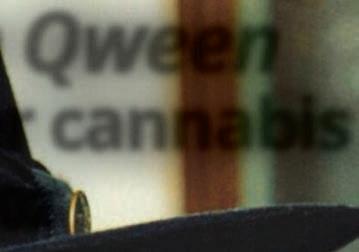

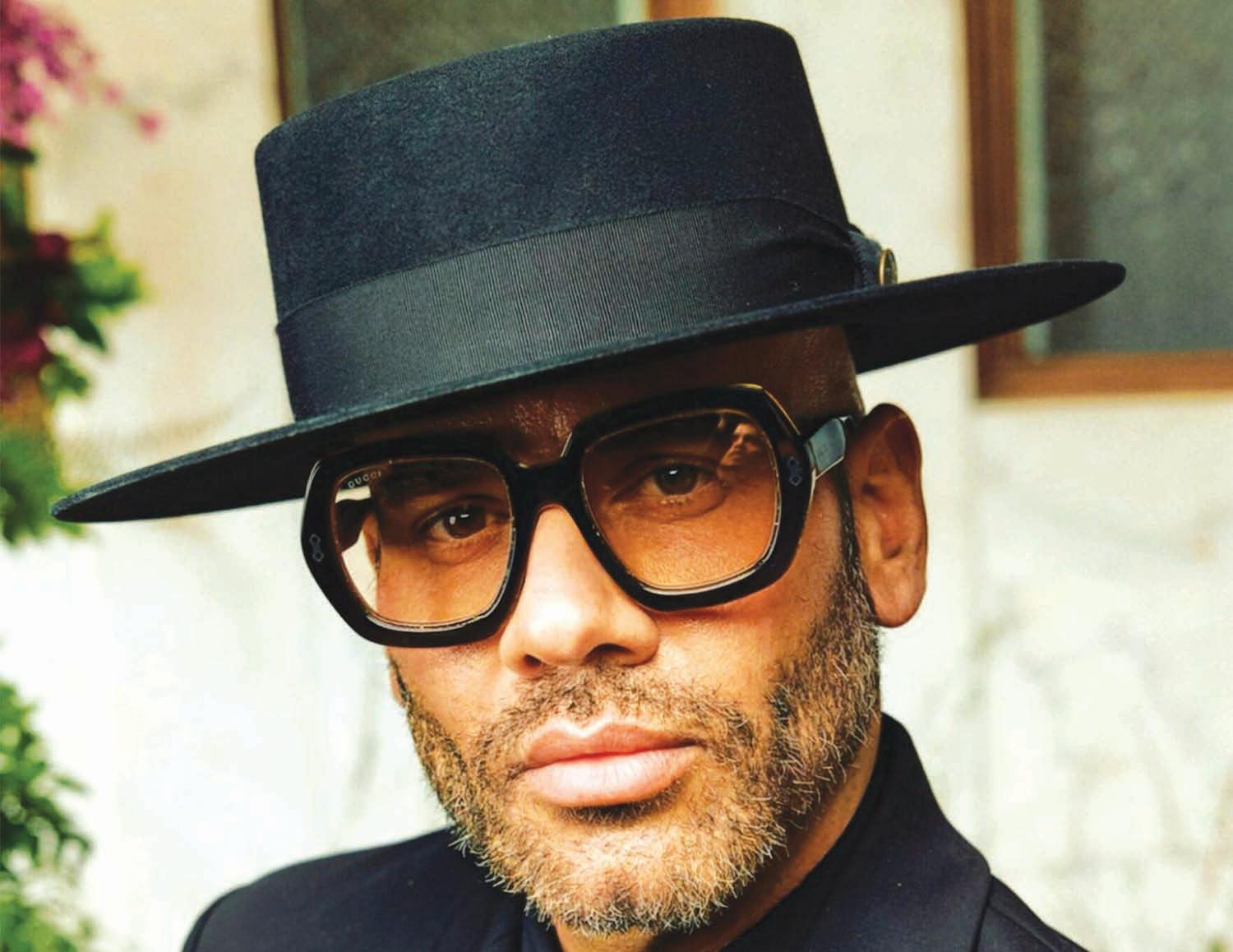
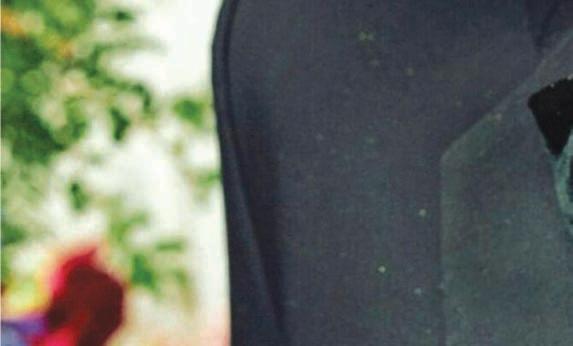
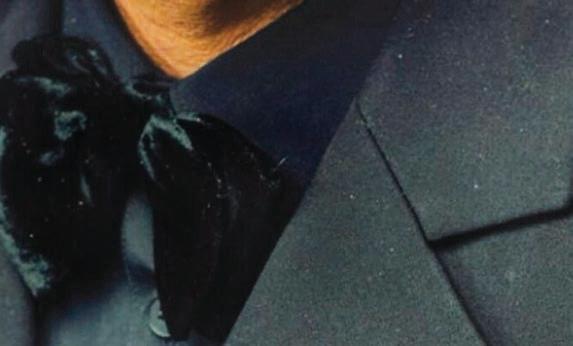
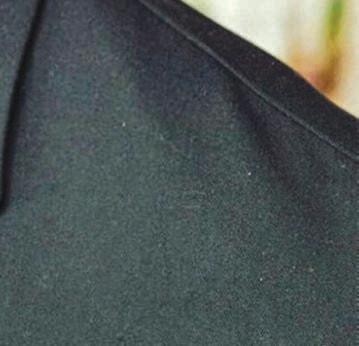













By ROB SALERNO
For more than two decades, Andrés Rigal has been a fi xture in Los Angeles’s LGBTQ nightlife scene, pioneering a diverse portfolio of events from EVITA to Summertramp and DTLA Proud. But recently, the nightlife mogul expanded his business holdings by launching Green Qween, LA’s fi rst cannabis retailer dedicated to serving the LGBTQ+ community.
Green Qween offi cially launched in 2022 as a partnership between Rigal and Taylor Bazley with its fi rst location in DTLA. After overwhelming success, it has expanded to a new location in the heart of West Hollywood at San Vicente and Santa Monica, in partnership with “ CEO of Everything Gay” Tristan Schukraft.
With Rigal set to be a featured panelist at Loud & Proud, an event celebrating the same-titled digital docuseries about the history of the queer cannabis community at the Abbey on Aug. 28, and presented by the Los Angeles Blade, Culture Machine , and the Last Prisoner Project, we spoke with Rigal about the challenges and opportunities that come with being a queer retail pioneer.
(This interview has been edited for brevity.)
Blade: How did your background in queer nightlife prepare you for the cannabis retail business?
Andrés Rigal: For more than 20 years, I’ve had the privilege of producing queer nightlife in Los Angeles, always with the community at the heart of every brand I create. My focus has always been on creating spaces that celebrate the full spectrum of our vibrant, multifaceted LGBTQ+ community.
Early on, I recognized a gap. So much of queer nightlife felt exclusive, catering to narrow circles instead of embracing our diversity. That realization became my mission: to break down silos and create events where every corner of the LGBTQ+ family feels seen, celebrated, and invited to the party.
At Green Qween, we’ve centered the queer community in every aspect of our brand. Proceeds go directly to local queer-led nonprofi ts, ensuring our success supports the community that laid the foundation for this industry.
For me, entrepreneurship is about more than building businesses. It’s about creating platforms that amplify voices, foster inclusivity, and celebrate the diversity that makes our community so extraordinary.
Blade: Why do you think it’s important to have an LGBTQ-focused cannabis store? What does Green Qween provide that other cannabis retailers don’t?
Rigal: To open Green Qween WeHo, we had to fi rst transfer our cannabis license from a previous address to our current location. This meant we had to make our
case for the transfer in front of the West Hollywood Business License Commission. That night we had more than 30 people from the community show up and speak on our behalf, something the commission said was unprecedented. Community members shared personal stories about the importance of seeing queer and trans employees at the DTLA store, and why queer representation matters even when shopping for cannabis. The commission then voted unanimously to approve our license transfer and said Green Qween would be “a net positive for the community.”

At Green Qween, we invest in our community with the intention that the community’s success is an indication of our success.
Blade: How has business at the new location in Weho been going? How does the store experience
compare to the downtown location?
Rigal: Green Qween WeHo is a runaway hit. Before we opened, people were clamoring to know when our grand opening would take place. Now that we’re open, it’s been non-stop. People love our friendly and knowledgeable staff , the delicious interior design and, of course, the fi ve-foot disco ball that sparkles day and night.
The WeHo experience is similar to our downtown location. Although the color palette of the stores are slightly diff erent, you know it’s a Green Qween when you walk in. In DTLA you get the same amazing service, the top selection of cannabis, and our stunning post-modern design with an enormous, shimmering disco ball. Our DTLA store is an icon while our new WeHo store points toward the future.
Blade: How do you see cannabis culture intersecting with queer identity/community? Do queer people have a special connection to cannabis?
Rigal: The LGBTQ+ community signifi cantly shapes pop culture, and this includes the intersection of cannabis culture. LGBTQ+ activists created the medical market in California during the HIV/AIDS epidemic of the ‘80s and ‘90s. Since then, we’ve been pushed out of the industry, which is one of the reasons we’re here to take up space and reclaim our legacy.
Blade: How have you seen the queer community’s relationship to cannabis change or evolve over your time as a fi gure in the community?
Rigal: I’ve seen the queer community embrace cannabis more over time, especially as stigma is reduced and it becomes more mainstream. People turn to cannabis for so many reasons, including medical, recreational, spiritual, and even as a more mindful alternative to alcohol. Cannabis truly is plant medicine and can help people just as much as it can facilitate a good time.
Blade: What are you planning to discuss at the Loud and Proud panel? What do you want people to take away from it?
Rigal: At the Loud and Proud panel, we’ll cover nightlife and cannabis in the queer community. I hope people will take away a feeling of pride in our community’s contribution to cannabis culture and a sense of ownership to further steward a future of plant medicine that honors this history.
(Green Qween is located at 802 N. San Vicente Blvd in West Hollywood. “Loud and Proud: Tracing the Smoke Back to Its Source” will take place at the Abbey, 692 N. Robertson Blvd. on Aug. 28 from 6-9 p.m.)


a place
The park, which is also one of the largest in the city, sits among a grand population of working-class people, immigrants, street vendors and people dealing with mental health.
By BRENDA VERANO
MacArthur Park, located in the Westlake neighborhood of Los Angeles, California, one of the city’s first parks, was once one of the most popular outdoor retreats at the turn of the twentieth century.
The park, which is also one of the largest in the city, sits among a grand population of working-class people, immigrants, street vendors and people dealing with mental health.
The almost 30-acre park recently made national headlines for being under heavy military and armed occupation of federal agents, specifically from the Department of Homeland Security, as well as National Guard troops.
The sweep, which occurred in the early morning of July 7, featured agents occupying the park with horses, armored vehicles, rifles and other tactical gear at a time when the city had been the ongoing target of ICE raids.
The park has also become a prevalent location for drug use and overdoses, despite the city’s ongoing effort to turn it around.
However, the park, which in the 1800s was an unwanted block of land used for decades as a city dump, has become a park fostering community well-being, immigrant experiences and environmental narratives.
“MacArthur Park is one of the most beautiful parks in the city with a lot of issues around it, but with a lot of opportunity and a lot of community that recognizes its value,” said Eunisses Hernandez, the councilmember of L.A. s first district, where the park is located.
In 2024, the park secured $2.5 million to fund the Reconnecting MacArthur Park Project launch, which would regain more green spaces for people and less for cars. The funds would help assess the feasibility of reconnecting the two sides of the park, which have been intersected by Wilshire Blvd., which passes right through the park and is one of the most used streets in L.A. This would involve closing off a portion of Wilshire Blvd from vehicular traffic and regaining public space for direct community use.
Hernandez stated that the park has been one of her district’s top priorities since she took office in late 2022, but years of neglect and a lack of funding have made it challenging for the park to be utilized to its full potential. In the last few years, the city council and Hernandez s office have secured millions of dollars to improve the park and enhance safety for nearby residents. As stated in a recent motion, the council district has secured at least $25 million in grants and collaborations with the county, state and federal governments, as well as partnerships with private foundations, to address both the urgent and long-term needs of the park, including over $1 million for dedicated clean teams six days a week and $950,000 for peace ambassadors seven days a week.
Hernandez’s office has also partnered with the L.A. Mayor’s office to upgrade street lighting and increase the presence of Crisis and Incident Response through Community-led Engagement (CIRCLE), a 24/7 unarmed response program that deploys a team of mental health professionals and individuals
with lived experience to address non-violent LAPD calls related to unhoused individuals experiencing crisis.
“Right now, I’m trying to turn the Titanic, and I didn’t realize how much weight the Titanic had and how difficult it would be. But MacArthur Park is not something that we’ve given up on,” she said.
Hernandez said she will continue to seek additional funding for initiatives that contribute to the infrastructure and safety of MacArthur Park.

In April, her office called for additional funding for the park and introduced a motion calling for a report on potential funding sources to maintain staffing plans for several services and programs at the park and within a half-mile radius for the period from May 2025 through June 2026.
She also asked for $69,500 for a tree project along the Alvarado Street vending corridor and $1.2 million for the construction of a public restroom. The funding will also tackle some of the park’s most crucial issues, which include illegal dumping collection in alleys around the park, park beautification, solarized lighting, graffiti removal, special event support and public restroom maintenance, among other items.
“MacArthur Park is a neighborhood, a community; more than anything, it’s a place of opportunity,” Hernandez said. “With the proper investments, with the proper care [the park] can meet the promise that the community expects.”
Hernandez also said one of the things her office is currently working on is restoring the water quality levels so that there can be recreation done on the park’s lake, as well as working with the street vendors in this area to educate them about knowing their rights while vending around MacArthur Park, which is home to one of the largest open markets in the country.
The park serves about 41,000 residents living within a half mile, as well as the 22,000 riders who pass through the Westlake/MacArthur Park Metro station and six major Metro bus lines daily.
It is also surrounded by several influential institutions, such as the Mexican Consulate, UCLA Labor Center, L.A. County Department of Public Social Services, Charles White Elementary School, MacArthur Park Elementary School and Fire Station 11,
which is one of the busiest fire stations in the country.
“While the population of the MacArthur Park neighborhood has significantly grown according to both formal and informal counts, public investments in municipal services and the social, economic and infrastructure needs of the neighborhood did not keep pace,” Hernandez wrote in a motion. “This has resulted in an area characterized by deep poverty, uncleanliness, and crime… The communities that have made MacArthur Park and the surrounding area the vibrant hub of culture, food that exists today demand and deserve appropriate investment to meet their needs and the needs of the people who pass through on a daily basis.”
However, the park continues to be a space filled with thriving community, resilience and memories. For years, the park has also been a historical and important site for community defense and political and social justice demonstrations, as well as other forms of activism.
In the past, it has been the site of large-scale rallies and marches related to workers’ rights, immigrant rights, and other social justice issues like Proposition 187. One of the biggest marches hosted at the park every year is the Labor Day and May Day marches, organized by local unions and immigrant rights groups.
Last Saturday, August 8, the park was also home to an action titled “Take Back MacArthur Park,” in reference to the July 7th federal occupation of the park and the various ICE raids that have occurred in a Home Depot, less than a mile away from the park.
The community and a coalition of over 50 organizations across L.A. met in the park to talk about the importance of community defense amid the ICE raids and holding businesses like Home Depot accountable for their alleged cooperation with federal agents.
“MacArthur Park has a tradition of being a park where community members and activists gather to fight back against repression, violence and harm, particularly to our most vulnerable communities,” Hernandez said. “Right now, it’s one of the locations where we have organized community defense training. MacArthur Park as a park and the neighborhood have not had a choice but to be the gathering spot for the communities that are always severely impacted disproportionately by a lot of the issues facing our city.”
In the summer, the park is also host to the Levitt Pavilion Los Angeles concerts, which take place inside the northwest corner of MacArthur Park. As stated by Levitt L.A., each summer over 60,000 people of all ages and backgrounds gather on the lawn of MacArthur Park to enjoy free live music and concerts, organized to make live music accessible to all and foster stronger and more connected communities. Every year, the concerts feature acclaimed emerging talent and seasoned, award-winning performers such as La Sonora Dinamita, Inspector, Kinky, Eddie Chacon, Los Abandoned and more.

Nick Drake talks bringing queer flair to “& Juliet” and the importance of non-binary representation on the stage.
By MATT MINTON
Since “& Juliet” hit the Broadway stage in 2022 with Paulo Szot, Stark Sands and Betsy Wolfe leading the cast, the show has brought its pop anthems across the world. Spanning Australia, the UK and Germany, this modern flip on Shakespeare is now continuing its North American Tour with a four-week run in Los Angeles.
“& Juliet” plays at the Ahmanson Theatre from Aug 13-Sept. 7, with a cast including Original Broadway Cast member Rachel Simone Webb. The ensemble is rounded out by Paul-Jordan Jansen, Teal Wicks, Corey Mach, Kathryn Allison, Michael Canu, Mateus Leite Cardoso and Nick Drake, who plays May, Francois’s non-binary love interest in the show.
The original play has a notoriously tragic ending, but “& Juliet” grants Juliet a second chance after she decides to give life another go. May is one of many new additions to the “Romeo and Juliet” story and Drake gets to hit the stage running after their first Broadway show, “Back to the Future.” Drake has also made numerous on-screen appearances, with credits including “Fire Island,” “Saturday Night Live” and “The Tonight Show with Jimmy Fallon.”
Ahead of the show’s premiere, The Los Angeles Blade had the opportunity to ask Drake about their experience playing the non-binary character May, giving a Shakespeare story some queer flair and how the show has evolved since its Broadway debut.
Can you talk about how you fleshed out and connected to May as a character and the significance of them being non-binary, especially as a non-binary actor yourself? What does this representation mean to you?
Since May is not a part of the Shakespearean catalogue, I get to create an entire persona out of a name and some lines. I remembered when I, too, was a baby gay and finding my identity. I tried to bring as much of myself into May and create the character from there! I wish when I was little, watching shows at The Fabulous Fox Theatre, I saw a character like May onstage. I would be so inspired and feel so seen as a Black queer person. Now, I get to be that role model for queer people across the nation and get to meet queer people after the show, and that just makes my heart so happy!
What makes the story of “Romeo & Juliet” so fitting to have a queer twist and love story?
Frankie and May make the “forbidden love” trope even more exciting! Since May technically sees Juliet kissing Frankie after Frankie and May meet at the party, May and Frankie can’t help but be in love with each other and have this secret relationship. The stakes are so high!
What have been some of the most exciting developments in this show on its North American Tour since the 2022 Broadway debut?
We have more choreography because we don’t have a turntable! The best example is during “I Kissed A Girl!” Mateus and I have this cute “Fred & Ginger” dance moment that is so Old Hollywood and just full of love.
This show is filled with pop anthems, many by icons like Britney Spears, who are beloved by the queer community. What are the most fun songs to perform?
Definitely “Show Me Love!” It is my favorite number in the show. I love Robyn so much. The second contender, even though it leaves me so out of breath still, is “Domino.”
What are you most excited about in getting to perform this show in Los Angeles and experience the theatre scene here?
I have never spent more than a week in LA and it’s always been for work at the Bourbon Room, which is amazing and I love it there. However, this time I’m here for a month, in a cute Airbnb and with a car! I can’t wait to kind of feel like I am living in LA, I have always wanted to live here — this time, I’ll get a true taste of that.
Is there anything else you want to add or mention about the show as it approaches? Be ready to have the time of your life. Scream, shout, and let it all out!
“& Juliet” runs Wednesday, August 13 to Sunday, September 7, 2025 at the Ahmanson Theatre, Los Angeles / Tuesday, September 9 to Sunday, September 21, 2025 at Segerstrom Hall, Segerstrom Center for the Arts, Costa Mesa.


By JOSEPH REBERKENNY | jreberkenny@washblade.com
More than 200 people gathered in front of the old Frank Reeves Municipal Center on Monday to protest the Trump administration’s federal takeover of the District of Columbia and MPD.
Free D.C. — a nonprofit whose mission is securing self-determination for the District — hosted the event at 14th and U streets, N.W. Speakers from several community organizations addressed the crowd, arguing that the takeover harms the city more than it helps.
Keya Chatterjee, executive director of Free D.C., was among the first to speak. She said the administration’s actions represent a blatant overreach of federal power, motivated by partisanship rather than public safety.
“Since last week, Trump has sent federal law enforcement agents into our neighborhoods, made our police start turning people over to ICE, sent in our local National Guard and attempted to put our local police department under federal control,” Chatterjee told reporters and protesters. “Today, he has sent in armed National Guard from three additional states.”
By Tuesday morning, six states had pledged to send troops. All are governed by Republicans, contributing anywhere from 150 to 400 National Guard members each. Together, more than 1,000 out-of-state troops are now expected to patrol the District.
Louisiana Gov. Jeff Landry pledged 150 troops; West Virginia Gov. Patrick Morrisey said he would send between 300 and 400; South Carolina Gov. Henry Dargan McMaster pledged 200; Ohio Gov. Mike DeWine said his state would send 150; Tennessee Gov. Bill Lee committed about 160; and Mississippi Gov. Tate Reeves pledged 200.
Chatterjee was not alone in criticizing the presence of non-D.C. officers. Jesse Rabinowitz of the National Homelessness Law Center said the money spent deploying troops could instead be used to house people experiencing homelessness — many of whom, he argued, the administration is targeting for removal.
“According to estimates, it costs over $420,000 a day to deploy the D.C. Guard,” Rabinowitz said. “That number does not factor in the Guard troops now invading from West Virginia, Ohio and South Carolina. But just using this D.C. cost — $420,000 a day — tells an important story. It costs $47,000 a year to get somebody off the street and into housing for one year. For one day of D.C. Guard activation, we could solve homelessness for nine people.”
He added that the clearances are designed for optics, not solutions.
“On Thursday night, over 30 federal police officers from the FBI, Secret Service and Homeland Security gathered near a few tents in Foggy Bottom. They didn’t come offering housing or support. They came with their guns and lights flashing.”
“The solution to homelessness is housing,” he continued. “The solution to authoritarianism is solidarity.”
Kelsye Adams, director of D.C. Vote and Long Live Go-Go, also condemned the use of the U Street corridor as a staging ground for federal forces.
“For the first time in history, a president seized control of our local government,” Adams told the crowd, which booed loudly in response. “He stripped away local authority unlawfully as our AG got out there and filled our streets with over 800 National Guard troops from other states, federal agents, including ICE, FBI … And where did they land? Right here on U Street, on Black Broadway in the middle of our door.”
“They call it public safety, but here’s the truth: crime is down in D.C.,” she continued, citing Department of Justice data ignored by the administration. “This is the lowest that violent crime has been in D.C. in the past 30 years … If crime is down, why all the troops? Why ICE? Why remove the unhoused? Why checkpoints and why say this is about safety? Let’s be real. This is a fascist takeover.”
Adams stressed that Black and brown children living around U Street are bearing the
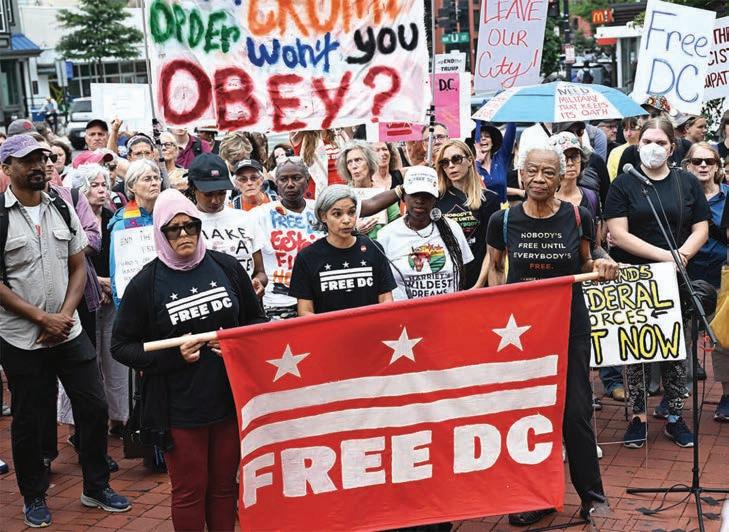
brunt of the militarization.
“Children should not feel like suspects for simply living; our young people deserve joy, safety and dignity, not militarization.”
Nee Nee Taylor, organizing director of Free D.C., echoed that message, pointing to the long history of police targeting youth of color.
“Black and brown people, we are not safe,” Taylor said. “We are in a state of emergency right now. We are being watched. We are being targeted, and it’s not safe to walk alone.”
“They want to drag us back to the days of Emmett Till and Jim Crow, but hear me clearly — we’re going to resist. We’re going to show up. We’re going to take up space, we’re not going to comply, and we’re going to send joy while we’re doing it.”
“Safety cannot be manufactured through fear. Let me say that again: safety cannot be manufactured.”
A representative from Colectivo Familias Migrantes, a civil society group focused on human rights and democratic rule of law in the Americas, told the crowd that incidents of undocumented people being scooped up in unmarked cars by masked agents are part of a broader plan to continue policing Black and brown people in D.C. — regardless of their immigration status.
“These are not coincidences. These are strategically placed and targeted to bring fear and panic, all while building a disgusting narrative that continues to criminalize our bodies every single day.”
“We demand that all federal forces leave now,” she added.
Rach “Coach” Pike, co-owner of the queer bar As You Are in Southeast D.C., told the Blade they attended the event to show solidarity and to stress the importance of LGBTQ awareness.
“I think it has more to do with location and who they’re targeting, which are Black and brown communities, communities that are unhoused. So I think it’s more about that than queer people — at least for now. Queers aren’t the focus yet.”
As a business owner, Pike said their priority is supporting those being directly targeted by the administration — and encouraging other businesses to do the same.
“I just encourage business owners, mostly to be on the street, help with the resources they can communicate and get information out to people, and push people toward our amazing D.C. organizers, because they’re the ones we need to follow right now.”
“Being out here with our people and amongst like-mindedness is really important to kind of get your energy up,” Pike added. “I wouldn’t say I feel any better — it’s all bullshit — but I feel surrounded, wrapped up, covered. Like I’m getting more information to help cover other people. You know, we got to keep us safe.”
FORTY YEARS of progress
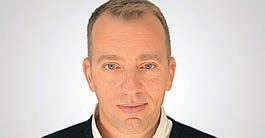
is editor of the Washington Blade. Reach him at knaff@washblade.com
This is what martial law looks like: rights trampled, businesses shuttered
President Trump’s unnecessary and performative takeover of D.C. police raises many legal and ethical concerns that are already being litigated.
Last weekend, we learned that Trump plans to deploy National Guard troops from West Virginia, Ohio, and South Carolina in addition to the 800 or so Guard troops already on D.C.’s streets. Their presence is intimidating and scaring away customers from local businesses, including LGBTQ bars. And it’s about to get worse as these troops — who are not trained in local policing tactics — may be allowed to carry guns.
Rather than preventing or solving crimes, these troops are setting up roadblocks and checkpoints, choking traffic and robbing American civilians of our basic civil liberties. They are creating disturbances around the city, drawing protesters into the streets and forcing businesses to close early, as the Blade has reported.
days of slow business brought about by Trump’s takeover. “I don’t know how I am going to stay in business with this Trump stuff,” he wrote. “The city was a ghost town last night. If this keeps up, I won’t be able to make payroll. People don’t understand how damaging this is that don’t live in DC. We have a great city and the only thing wrong with it is the idiot in the White House.”
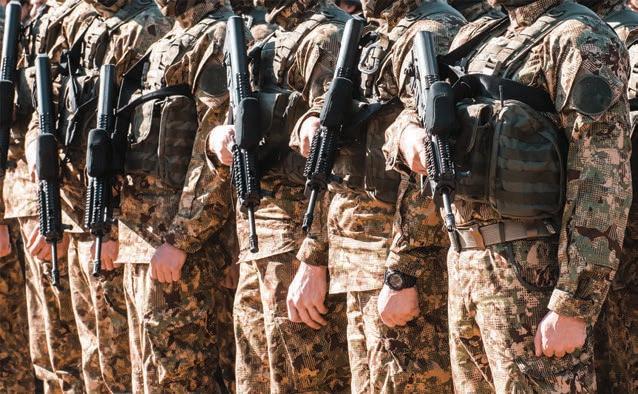
It is heartening to see so many local residents protesting these unconstitutional injustices, but anyone demonstrating should be mindful of the potential consequences of crossing the line from protest to violence. The government under Trump and Attorney General Pam Bondi is looking to make examples of protesters to deter further demonstrations. The same administration that pardoned all of the Jan. 6 rioters who broke into the Capitol, attacked and injured police officers, threatened to kill Vice President Mike Pence and Speaker Nancy Pelosi, and smeared feces on the walls of the building, is now pursuing felony charges against a protester who threw a sandwich at a law enforcement officer.
So protest we must, but be careful not to cross the line and end up in jail or worse.
Meanwhile, the ancillary effects of this travesty are being felt by local queer business owners. Crush bar had to close early last week due to staff feeling unsafe by the growing crowds outside its doors. Dave Perruzza of Pitchers posted on social media that he is worried about making payroll after
Perhaps more ominous is the prospect that what’s happening in D.C. is only the beginning — a blueprint for dispatching unwanted and unneeded troops to other Democratic cities (most of them governed by Black mayors, which is surely no coincidence) under the guise of fighting crime. Indeed, a swarm of Border Patrol agents was dispatched to a news conference in Los Angeles where Democratic lawmakers were meeting last weekend in a clumsily transparent attempt at intimidation. This is what martial law looks like and it’s what Trump is counting on to stay in power after his term expires in three years. We must all fight back against these authoritarian efforts. If you think it doesn’t impact you because you don’t live in D.C., just wait until he turns his attentions to Baltimore, New York, and Los Angeles.
Kudos to the Democratic governors who are resisting this madness. Maryland Gov. Wes Moore has asserted he will not authorize Maryland Guard personnel for use in crime suppression, which triggered a predictable attack from Trump. California Gov. Gavin Newsom has become Trump’s trollin-chief, mocking the president’s “tiny hands” and moving forward with a bold plan to redistrict the state to eliminate five Republican-held House seats. We need more political leaders to find their voices and backbones and take concrete steps to block Trump’s attacks on our democracy. In the meantime, keep up the protests and don’t be distracted from the need to open the Epstein files. And afterwards, go to your local queer-owned watering hole for a drink and some camaraderie. We could all use both right now.
PHONE 310-230-5266
E-MAIL arodriguez@losangelesblade.com
INTERNET losangelesblade.com
PUBLISHED BY Los Angeles Blade, LLC
PUBLISHER
ALEXANDER RODRIGUEZ
arodriguez@losangelesblade.com, 310-230-5266 x8080
EDITORIAL
NATIONAL EDITOR
KEVIN NAFF kna @washblade.com, 202-747-2077 x8088
CONTRIBUTING WRITER
KAREN OCAMB karenocamb@losangelesblade.com
CONTRIBUTORS
MICHAEL K. LAVERS, TINASHE CHINGARANDE, CHRISTOPHER KANE, JOHN PAUL KING, LOU CHIBBARO JR., SUSAN HORNIK, JOE REBERKENNY, DANIEL ITAI, ISAAC AMEND, PETER ROSENSTEIN, TERRI SCHLICHENMEYER, JOE PHILLIPS, ANKUSH KUMAR, ESTEBAN RIOSECO, SAM KISIKA, ELVIS KAWEDO, HENRY CARNELL, DAWN ENNIS
SALES & ADMINISTRATION
SALES EXECUTIVE
SHANA WONG SOLARES swong@losangelesblade.com, 808-386-0872
MARKETING DIRECTOR
STEPHEN RUTGERS srutgers@washblade.com, 202-747-2077 x8077
NATIONAL ADVERTISING
RIVENDELL MEDIA
sales@rivendellmedia.com, 212-242-6863
ADMINISTRATION
PHILLIP G. ROCKSTROH prockstroh@washblade.com, 202-747-2077 x8092
CREATIVE DESIGN/PRODUCTION
MEAGHAN JUBA production@azercreative.com DISTRIBUTION
CHRISTOPHER JACKSON, 562-826-6602






Grindr has leveled up from flirty (and sometimes endless) chats to a full-on curated cultural platform for the sex positive queer community. Will it be the future of queer connection or a digital minefield waiting to detonate?
By AJ SLOAN
Cruising once meant lusty side-glances in our cities’ inconspicuous public parks, pubs, and even the phone booths at Macy’s. Nowadays it’s the far too familiar swipe, grammatically flawed DM, and the vast sea of headless torso pics. Grindr, once the ever so modest rosebud of today’s digital gay cruising, has now bloomed into so much more, upping its game with new features similar to other social media platforms, infusing it with AI matchmaking, and uncensored content under one rainbow - tinted roof. Is the only connection that matters these days a decent Wi-Fi connection? Arguable.
Grindr’s legacy began as the grid‑style, location‑based hookup platform that we all know and love… to delete only to reinstall two days later. Simple, sexy, and surface-level satisfying. Today, however, Grindr is going under a bit of a nip/tuck. Infused with AI‑powered personalization (think of it like an AI wingman), global discovery (“Discover”) and travel tools like “Explore Heatmap” and “Travel Pass” that give you jet‑setting Gayborhood vibes in real time.
Already at play is the new feature Right Now , a lusty live - feed not too different from a disappearing story on poppers - post a pic or text that vanishes after an hour - with users now able to signal, “get in me bro,” getting straight to the di… to the point.
But Grindr hasn’t stopped there. Queue Grindr Presents , a hot hot hot new in - app content hub that offers all types of queer media like video series (hello, Katya’s Who’s The A-hole? ), playlists, editorials, behind-the-scenes tour clips, and then some. A pinch of Instagram, a touch of TikTok, a mouthful of YouTube, all intertwined into our shiny new Grindr.
At the core, it’s your hookup app and a commune of queer media. Your one - stop stop shop for one (hopefully) uncensored and fabulously fae content feed. Grindr describes it as “an unapologetically safe space where the community can be themselves, be heard, and be fabulous without fear of suppression.” Cool, yes, but what about the unfiltered side of that freedom?
With this digital facelift, Grindr Presents could quite possibly be a girthy gold mine. For adult content creators, it has the potential to be the new brightly lit stage for visibility to fuel income. Expand your brand beyond X, Bluesky, and other password - protected peen clad platforms. Get attention from a captive (and c*ck hungry) audience right when they ’ re browsing for… connection
For creators, the above-mentioned AI features help users reconnect. A-List picks out your hottest yet perhaps more reluctant potential matches, giving creators more chances for recurring benefactors. Chat summaries allow casual viewers to re - engage without repeating the same flirtatious verbiage. Meanwhile, global discovery tools have the potential to reach new audiences for your content without a passport or risking flying out from Newark.
Let ’s talk about Sniffies for a moment. For those who are unfamiliar, Sniffies is our beloved map - based cruising platform that didn ’t bat an eyelash at explicit photos and mapped nearby users and cruising grounds worldwide. It made its iOS debut in March 2025 only to be yanked by Apple around late May due to “ongoing content restrictions” despite implementing a “ Safer Work Mode.” The website remains, but the app was scrapped.
This brings up a deliciously delicate question: could Grindr face the same fate? Both Grindr and Sniffies cater to queer cruising, and both push sexual content boundaries of the status quo. The difference is that Grindr has been Apple‑approved to this day. It does have the authority to sanitize profile pictures (would you settle for PG 13?) and frames itself as “dating” as opposed to cruising or hooking up. Sniffies ’ unapologetically overt purpose to get down likely was the catalyst for a multitude of sanitized corporate scrutiny whereas Grindr ’s more nuanced facade was given the green light. Still, with Grindr Presents delivering uncensored queer media, even if curated , the
Apple gods might clutch their pearls. Particularly in our current political climate where queer content is increasingly met with rigid censorship. But Grindr ’s mainstream status and framing as a “ social hub ” rather than purely pornographic might give it more freedom, for the time being at least.
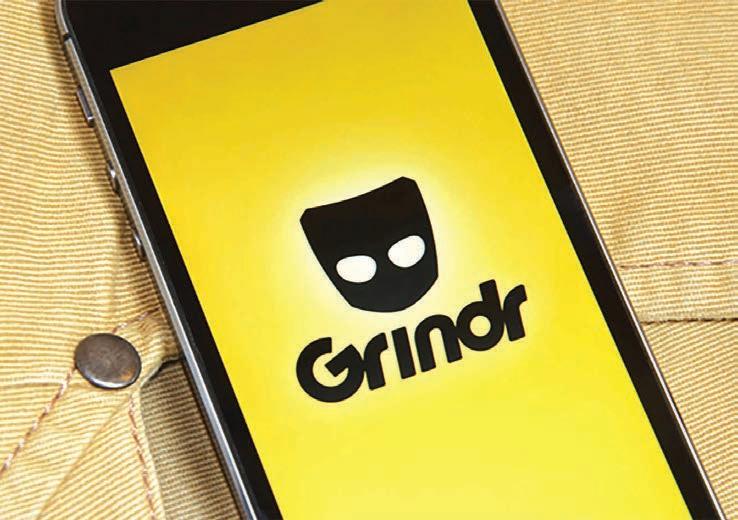
With Grindr being so free from censorship and regulation, it teeters on the familiar fine line between freedom of speech from salacious to unsavory. Let ’s look at X as an example, the same platform that gave voice to the Black Lives Matters Movement while also holding space for white supremacists. On one side of the coin, no censorship means creative freedom, raw authenticity, spontaneous connection, and radical queer expression. On the flip side, it opens the door for hate, trolling, fetishization, and unsafe content to flourish if left unchecked, especially for vulnerable communities.
Grindr ’s task then is to enable expression without sliding into the waters of harmful content or hate speech. The platform ’s safety, moderation, and responsibility will inevitably be tested. Without a watchful eye, Grindr Presents could become a megaphone for extremist and regressive voices, or at the very least, spotlight internal community biases. Yes, free speech is hot, but unmoderated speech can be a real buzzkill.
Only time will tell which trajectory Grindr is set on. Ignite an eruption of queer creativity and creator- centric monetization, or get tangled in regulatory red tape, or worse, push back from within the community. Grindr has evolved from a quintessential hookup app into a multifaceted platform functioning as a gay social hub and media outlet. In today ’s climate of growing anti - queer censorship, the challenge will be striking a balance between moderation and freedom of expression.
So, sweet little cruisers, charge your iPhone, swipe that grid, and drop into Grindr Presents. Let your curated content ride the wave. The digital cruising scene is evolving, and Grindr is the savvy (and maybe scandalous) chauffeur ushering us into a new day and age of getting that d . Let ’s buckle up and pop our PrEP. It’s gonna be a wild ride.
‘King
King Perka $exxx and Big D share what inspired them to do King of Drag, the filming process, and the path for drag kings.
By NORMA LEE
In the penultimate episode of the world’s first drag competition show, King of Drag, two contestants would be sent packing with their packers before the big finale. The five fan-favorites had to create original looks from scratch, lip sync to “Good Boy,” and come up with an interpretive dance to earn their spot in the top three of the Revry series. Unfortunately, two fan favorites didn’t make it past the final hurdle: King Perka $exxx and Big D. Big D has big P-personality. The one-of-a-kind character actor had never lip-synced before this episode, but judges loved what Big D brought week after week. Of the five weeks he competed on the show, Big D was in the top three times! His background in clowning helped him to bring such vivid and memorable characters to life on King of Drag. On the other hand, King Perka $exxx had a much bumpier road, but throughout that journey, audiences fell in love with the performer we got to know. From his perfect Urkle to his hilarious stand-up routine, Perka $exxx was the heart of King of Drag season 1. To lose them both before the finale was tough for fans. But fingers crossed for an eventual King of Drag All Stars
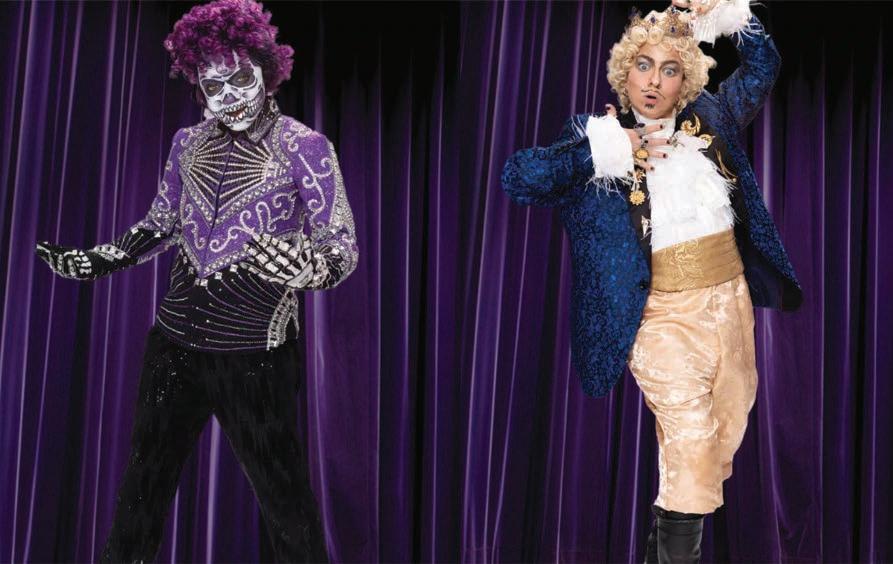
The LA Blade caught up with Perka $exxx and Big D to talk about their experiences on King of Drag, advice for other kings, and what they would do differently. Tell me about your first time in drag.
KPS: My first number was last at my college drag show, and I didn’t wanna wait a year till the next school show, so I went out and hit the city.
BD: Drag was a gradual process for me, from my dad teaching me to do a double Windsor when I was in middle school, to suits, fedoras, pocket watches and worshipping macho-intellectual books and movies in my teens and 20s, to a slow realization that I could BE the thing I secretly worshipped, that I didn’t have to have my face pressed up against manhood’s window anymore. I could do the damn thing.
What made you decide to be a part of the inaugural season of King of Drag? What do you hope to see differently in future seasons?
KPS: I had half my timeline tagging me in the audition posts, so partly peer pressure. I went back and forth on whether I should do it, but I had to stop thinking and start doing it. I just did the best I could on my tape, and I was myself the entire time, and I always made sure to have fun. I want future seasons to have more episodes and more days off to sleep in.
BD: Murray was my main motivation. He was the artist who inspired me to really step into drag, and I cheered along as his career grew from clubs and live shows in NYC to TV and film. The chance to connect with him was impossible to pass up. I still pinch myself that I have his number in my phone, and that he let me borrow his Doc Martens for one of the shoot days.
What surprised you most about your experience on King of Drag?
KPS: That we were able to be competitive, and not be bitches to each other like I’ve seen on other shows. I shouldn’t be surprised though – drag kings are just built differently.
BD: I was celebrated far more than I thought I would be. I thought I would be read to filth for my lack of polish, but I was more often than not encouraged and deeply seen by my castmates, by production, and by the judges.
What do you cherish most about your filming experience?
KPS: I cherish the kindness of production and the moments behind the scenes with everyone.
BD: The connection with my castmates and with the fans of the show. The community that has come together to support this project. Being part of something much larger than myself.
If you could do one thing over on King of Drag, knowing what you know now, what would it be?
KPS: Drink more water.
BD: More stillness, more breath.
Have you had any especially memorable fan interactions since the show began?
BD: I want to inspire others to take up more space—and I’ve heard from kings and aspiring kings that I made them feel that they could do the damn thing, regardless of all the little things that can make us stop ourselves from doing the damn thing. If I made people feel that there is a place for their art, or even just a fuller flower of their soul, that’s awesome.
What do you want aspiring kings to know about the working life of a king?
KPS: Don’t quit your day job or ruin your day life over drag. You, as a human being, are still important, and you have to work twice as hard as queens, because you will have higher standards. When that happens, you need to rise to the occasion and prove the haters wrong
BD: There are a lot of ways to King: in theater, in comedy, in dance, in role play, in… probably knitting, you know? It isn’t just lip syncing in bars. Take kinging further, take it everywhere it’s needed.
If you can ask a co-star or Murray Hill one question at a season 1 reunion, what would it be?
KPS: I’d ask Murray to try one of these challenges. Like, c’mon, 90 minutes on the first day songwriting; I wanna see Murray try to do that.
BD: Hey, Murray, what size/make were those Doc Martens again?
Stream the entire season of King of Drag now on Revery.com and followKing Perka $exxx and Big Don social.

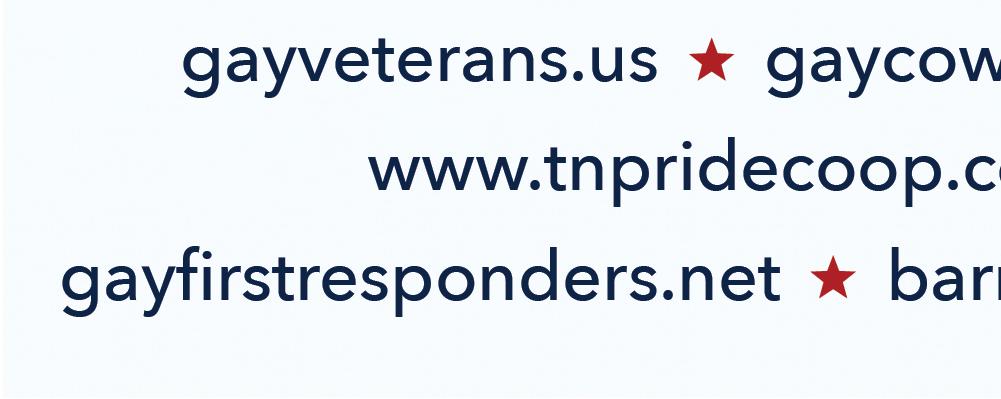
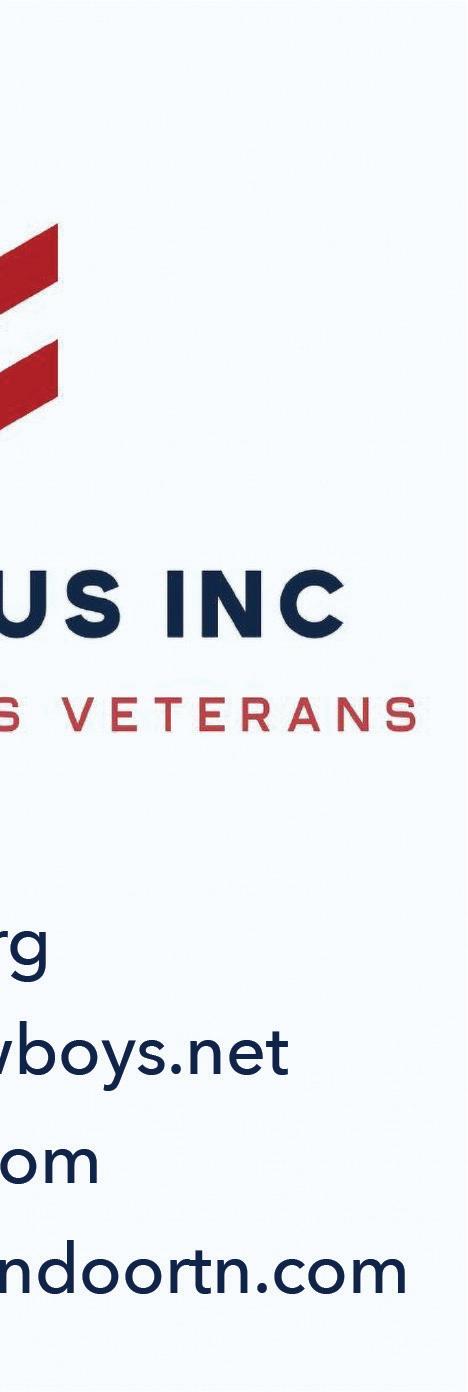
By JOHN PAUL KING
Like so many others of my generation, I first became aware of Terence Stamp when he appeared as General Zod in 1978’s “Superman,” and I was struck by the fact that, despite his relatively short screen time and the fact that I had never heard of him, he was featured in the movie’s advertising as if he were a major player.
As a budding young cinema nerd, that, coupled with the cool charisma he projected through his villainous turn as an interplanetary supercriminal, piqued my attention. It wasn’t long thereafter when a late-night broadcast of “Billy Budd” – the 1962 film version of Herman Melville’s posthumously published novella in which the then-young Stamp was first thrust into stardom – introduced me to him as he had been introduced to the world that came before me. And it was electrifying.
Here was a young actor whose breathtaking beauty was rendered even more irresistible by his palpable intelligence and his carefree disregard of contemporary standards of masculinity. I was captured by the ease with which he embodied his role as young 19th-century sailor, conscripted into service on a British warship and turned into an outcast for his gentle nature and optimistic spirit; pitted against an aggressively masculine superior whose obsessive dislike of him snowballs into tragedy, he embodied a quality that resonated deeply with parts of myself I was still not fully prepared to explore. Though I may have been too young to catch all the obvious queer subtext that was built into the story by Melville himself (Google it if you’re skeptical), I knew that there was something about this movie that had been ignored or missed outright when it was released. The film was largely dismissed as a weak and pointless effort, almost certainly because of a refusal to acknowledge its homoerotic subtext – but that I somehow understood and into which I felt immediately entwined, all because I recognized something of myself in Stamp’s near-angelic personification of the role.
I was not the only one, nor was I the first. Coming into the public spotlight in a time when post-war British austerity was yielding to new and more socially aware attitudes toward masculinity and sexual expression, Stamp – who received his first and only Oscar nomination for “Billy Budd,” despite its lukewarm reception – soon became a fixture of “mod” popular culture, parlaying his confidently androgynous appeal into international stardom. He was a film star who worked with revered artists like Fellini and upstart auteurs like Pasolini, half of the era’s “it” couple with model Jean Shrimpton, and a jet-setting fashion plate as famous for his sense of style as for his skills in front of the camera.
Indeed, while he was the embodiment of his era’s particular flavor of fame and glamour, the kind of stardom afforded to more conventionally masculine UK-born contemporaries – like Sean Connery, Michael Caine, or Peter O’Toole – eluded him. Adored by the glitterati, he was ignored by the mainstream, who found his work in films like “The Collector” (as a deeply repressed sexual predator who kidnaps a young woman) or “Far From the Madding Crowd” (opposite fellow “mod” icon Julie Christie) too challenging, too ambiguous and vaguely transgressive to fully embrace, no matter the considerable appeal of his physical beauty. In hindsight, it’s easy to recognize the brilliance of his boundary-pushing work during these early “salad days,” but to the masses of the time, there was perhaps something too uncomfortable about the feelings he evoked onscreen.
And then, there was Pasolini’s “Teorema,” in which he played an angelic, otherworldly figure who seduces an entire Italian bourgeois family – mother, father, son, daughter, and maid – without regard for conventional notions of sexuality or socially condoned boundaries. More than any other film, perhaps, it was the lightning rod through which his entire film career would eventually be illuminated. Confidently embodying a radical vision of sexual fluidity before the language for such things was even available in common public discourse, he became a symbol of gender ambiguity decades before appearing in the film that would eventually cement his legacy as a queer cinema icon: 1994’s “The Adventures of Priscilla, Queen of the Desert,” in which his stately portrayal of a transgender
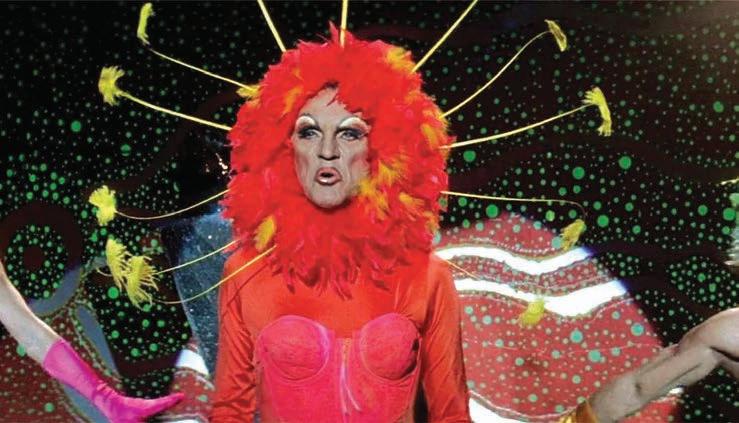
drag performer mentoring a pair of younger queerlings earned him a well-deserved and long-overdue “comeback.”
In the intervening years, of course, there was “Superman” and its 1980 sequel, in which he turned a one-dimensional villain into a fan-favorite symbol of elegantly campy outsider-ism. Before that, there was a retreat from the spotlight, during which he explored his spiritual side in India; after, he embarked on a whole new career of boundary-pushing projects (like Stephen Frear’s 1984 gangster-centered character study “The Hit”) and mainstream cameos (as in 1987’s “Wall Street” and 1988’s “Young Guns”). But it was “Priscilla” – despite a later appearance in the “Star Wars” franchise (in 1999’s “The Phantom Manace”) – that permanently cemented him in the cinematic firmament, embodying a dignified, confident, and utterly aspirational portrait of queer identity that continues to inspire today.
After my discovery of “Billy Budd,” all of Stamp’s work was on my radar; but alas, in an industry that values easy conformity over open-minded exploration, so much of his career remained obscured in the public eye by indifference; I went on the journey undertaken by countless fans before me, disturbed by “The Collector,” titillated by “Madding Crowd,” and thrillingly corrupted by the radical transgressiveness of “Teorema.” I was further drawn to his performances in “The Hit” and “The Limey,” and forever empowered by his unflagging commitment to challenging his audiences in a way I had to assume he wanted to challenge himself. In the end, there was far too little of Terence Stamp in the public imagination than he deserved – and that, perhaps more than anything else, made me enthralled by his unique place in pop culture history.
And while it may have been “Priscilla” that introduced him to a new audience of queer fans, just as “Superman” had brought him back into a spotlight he had long since abandoned, it was ultimately his fearless dedication to stretching cultural boundaries around sex, gender, masculinity, and identity itself that made him the unsung giant we are left to mourn in the wake of his passing last week, at age 87 – a personal hero for myself and the countless other queer people who saw what he was doing and found themselves magnified, validated, and truly seen because of it. Never content to be defined as a sex symbol, a leading man, or any other easily-categorized “type” (though he openly discussed his non-conforming sexual leanings, he always declined to identify as “bisexual” or “queer” or any of the other labels we all feel so compelled to embrace in our militant modern age), he instead embodied a spirit of open-minded exploration and individually-defined humanity, in which cultural boundaries and expectations are not only unnecessary, but counter to our national inclinations to live an authentic life.
If I had been a movie star, I would have wanted to be the kind of movie star that Terence Stamp was – and that is saying a lot.
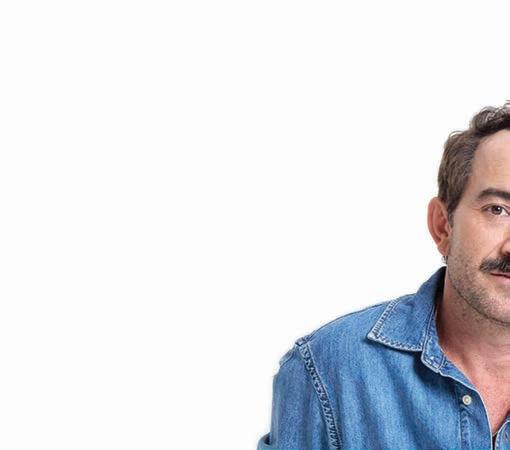

Even amidst gore and bloodshed, this bisexual actor finds the space to show his Pride.
By JOEL MEDINA
It’s a story that has been heard countless times before: someone feels the call of stardom, and they believe the only way to answer is to move across the country to Los Angeles. Entire libraries are filled with the unfortunate stories of these people, who often discover that the “City of Angels” is much harsher than it seems onscreen. But for the select few, they manage to find success in one of the toughest industries in the world. And for those like TikTok star Clayton Farris, they manage to do it while providing the LGBTQ+ representation our communities need now more than ever.

of Angels” is much harsher than it seems onscreen.

“I grew up in a very traditional Southern space, and I always just stood out because I was…I was different,” said Texas-born Farris when he sat down to discuss his new movie, Weapons. “I had a whole life [in Dallas] that I packed up and left — and as soon as I got to LA, I was like, ‘Oh, this is where I’m meant to be.’”
Anyone online in the past decade has seen Farris’s work. Before starring in numerous hit TV shows and movies, the man made his mark on Vine through comedy sketches (never again can someone ask for their keys without imagining a printer being hurled at them). Since then, he’s acted in hit series like Scream Queens and Ratched, all while becoming a mainstay in the LA comedy scene and amassing more than 400,000 followers on TikTok. Clayton brings his trademark style of irreverent humor to every project, all while proudly sharing his bisexual identity with the world — a sense of pride that didn’t come easy to him.
“Coming from a place that really encourages people to be closeted, it’s been a long journey for me to be able to be myself,” he explained when he sat down with the Los Angeles Blade, still tired from the Weapons red carpet he’d been strutting down only a day before.
“I always say: any character I play, I always bring the ‘bisexual edge’ to them.” The actor laughs but stresses the importance of this kind of representation, and the long journey it took for him to share his bisexuality through his art. Farris knows that it is essential to bring his authentic identity into every single role…even in a movie as terrifying as Weapons
Most horror fans are familiar with director Zack Cregger’s work; his previous film, Barbarian, is infamous for not only its jaw-dropping plot
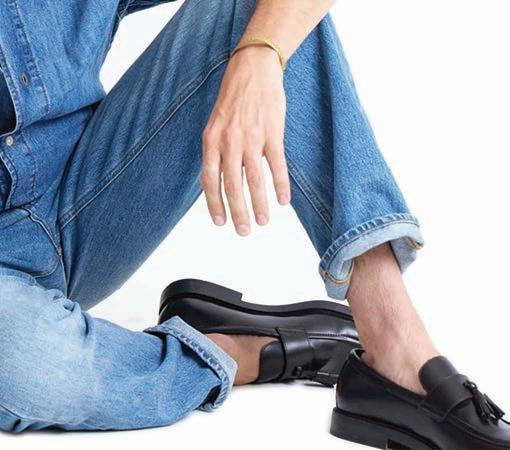
twists but the unceasing anxiety it carries throughout every scene.
twists but the unceasing anxiety it carries throughout every scene. His latest film, Weapons — a mystery-horror centered around a classroom of children who flee their homes in the dead of night — recently premiered and is already being lauded as one of the scariest movies of 2025. Yet somehow, amidst the thrilling bloodshed that its trailers are promising, it finds the space to feature LGBTQ+ representation through Farris’s role as Terry, the goofy, endearing partner of one of the main characters.
While he laughed about the quirks he brought to the character and what wild fun it is to star in a scary movie, Farris also recognized just how important this performance really is. “To be one of the only queer characters in such a big movie, [I was] like, ‘Oh, this kind of has some weight to it!’” he exclaimed, proud of injecting casual queerness into such a complex plot.
He went on to describe how, even at the premiere, there were executives coming up to him, thanking him for the representation and the nuances he brought to what could have been such a cliché stereotype. It’s a kind of representation that LGBTQ+ horror fans have fought decades for, and through Terry, Farris is proud to push it even further.
No matter where his career takes him next, whether it be in another gore fest like Weapons or some hit comedy show in LA, Farris makes it clear what his goal is as a bisexual actor: “I just want to do a good job, and represent the community well.” It’s a mantra that more performers should carry, and it’s what makes Farris one of the true standout comedy stars of Los Angeles (and TikTok) today.
other
Cecilio Asuncion, the creative force behind Cinepride, dishes on making space where stories don’t get watered down—they get loud, proud, and personal.
By AJ SLOAN
When Hollywood forgets the full flavor of storytelling, artists like Cecilio Asuncion bring the spice. With a creative compass pointed at authenticity, Asuncion has been serving up stories that go deeper than big box office regurgitations and sanitized clichés. In an industry that still misses the mark on nuance, especially when it comes to marginalized folks and their identities, Asuncion steps in with work that doesn’t just “check boxes.” He builds entirely new platforms, like Cinepride, a film festival born from the need to showcase stories that Hollywood still sidelines.
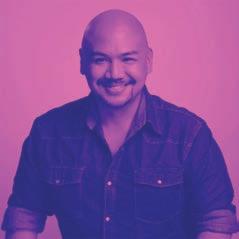
Let’s be honest - representation isn’t just about who gets the spotlight—it’s about who gets to hold the camera, write the script, and take a stab at tweaking society for the better through film. Whether he’s reframing tired tropes or elevating new voices through a cultural lens, Asuncion proves that storytelling is in need of purpose, not permission. We recently had the chance to talk with Asuncion about reclaiming narratives, making room for honest expression, and creating Cinepride from the ground up, and why the future of film might just be found far from the studio lot.
What was the moment when the idea for CinePride ignited? What was that creative process like?
CinePride actually came from a really difficult place. My husband passed away the night before Thanksgiving in 2023, almost two years ago now. Because I come from the independent filmmaking world, I thought, “You know what? This could be a meaningful legacy project.” Looking back at my career, I realized that so many doors had been opened for me, and I wanted to create a space where people could come together. Not in competition, but in collaboration.
That’s one of the things I’m most proud of with CinePride. We’re not trying to create another competitive film festival. I mean, you know how festivals can feel, so cutthroat, like a pageant. But that’s not the point. Especially as a gay Filipino immigrant, I’ve been taught that there’s only so much space for someone who looks like me. So naturally, we begin to see each other as competition. But CinePride is about dismantling that mindset. We’re starting fresh.
It’s like the whole “only one seat at the table” concept. Exactly.
What sets CinePride apart from other LGBTQIA+ film festivals?
We’re kind. That’s probably the biggest thing. And I mean that genuinely. Also, our programming is deeply intentional. We owe a huge thanks to the screening committee, our Programming Director Miguel Santos, and our Development Director Michael Daly. We made a conscious decision that “community” doesn’t just mean “gay.” It means honoring all
the different colors, identities, and orientations that make up our world.
Because I’m still actively working in the industry, I know what it feels like to be a filmmaker submitting to a festival. I remember when I did the rounds with my first documentary, What’s the T? I was so excited to meet people, but I got treated like I didn’t belong - classic mean-girl energy. Even that needs to change. Kindness and grace matter, especially when you’re already in the room. And for those submitting, whether to us or anyone else, graciousness will take you far. This industry is small. People remember how you treat them. We might not always be nice, but we’re always kind. That’s a big distinction.
One of your awards is for Best Micro-content. Can you talk about what that category includes?
It’s for films under five minutes. But we created it to make space for people without access to big budgets or fancy gear. Maybe all they have is their phone. It’s especially geared toward youth and emerging creators. And in a world of reels and short-form storytelling, that kind of work deserves to be seen too.
Another award that stands out is the Social Impact Award. What led you to create that, especially in our current climate?
Look at the world we’re in right now. I’m Gen X, and we didn’t grow up with social media. But today, I think we confuse posting with activism. And that’s not enough. We need to do something - whether that’s running a festival, helping at a food bank, or just showing up for our community.
When I worked on Strut and with Slay Model Management, I made it a point to connect with nonprofits doing real work for the trans community. They’re doing the heavy liftinghousing, healthcare, survival. Film and entertainment get all the attention, so it’s our job to spotlight the people who don’t get enough of it.
That all really resonates. It’s frustrating when people give a shout-out during an awards speech and then do… nothing.
Yes! I call it “fad-vocacy.” Like, don’t thank the trans community in your Emmy speech and then never hire them. Don’t wear a “Protect Trans Kids” shirt and then disappear. That doesn’t help anyone pay for groceries or hormones.
CinePride also includes panels and Q&As. Are there any you’re especially excited about?
Absolutely! We’re partnering with NBCU Launch, and I’m really excited about that. We’re bringing our community in front of actual decision-makers, people who might not have had that kind of access before.
I really believe in what Michelle Obama said: when you walk through doors of opportunity, you keep them open for others. I’m where I am because so many people helped me. I got to executive produce my first TV show with Whoopi Goldberg. That doesn’t happen to everyone, and I’ll never forget it. So now I ask myself: how can I do the same for others?
That’s powerful. What does “advocacy through film” mean to you? And how do you think Hollywood might be falling short?
Advocacy through film means telling the stories that matter and making sure they’re seen by people outside our community. We already know our own struggles. The goal is to reach others.
Now on Hollywood, It’s tough. Advocacy and business don’t always coexist easily. That’s why independent film is so important. Most of these filmmakers aren’t doing it for money - they’re doing it because they have to tell these stories. We’ve made progress in Hollywood, especially with authentic casting and representation, but we still have a long way to go. And honestly, I think when the current gatekeepers retire or… move on, your generation will do things better. Were there any unexpected challenges that came up while planning CinePride?
Surprisingly, no major wrenches. People warned me it’d be a huge undertaking - and it is - but when you’ve produced a full season of TV, a three-day film festival feels manageable. The bigger challenge is funding, especially from government sources. That’s why we leaned into private sponsors instead. I didn’t want to take money from trans organizations that need it more than we do. Thankfully, I’ve been able to invest in this project myself.
That’s both incredibly generous and intentional. You mentioned you moved from the Philippines at nineteen. How has your Filipino background shaped your work?
Honestly, my family wasn’t traditional. My mom was always supportive. We weren’t raised with rigid gender roles or cultural expectations. So I didn’t have a hard time adjusting when I moved here. But I’ve come to see how different that experience is. A lot of Asian peers have learned to stay quiet, to fly under the radar. I was never taught that. I’ve always been encouraged to speak up.
If you could make a cameo in any LGBTQ+ film, which one would it be?
It’s not technically LGBTQ+, but I’d say Death Becomes Her That’s ours now, right? That or Soapdish. I watched that movie over and over with my best friend Marco. So when I got to work with Whoopi? Full circle.
Would you rather watch a tearjerker or a campy comedy?
Sad movies are like porn - you should watch them alone. But comedies? Definitely with friends. I love ridiculous stuff like Scary Movie - Regina Hall’s Brenda is iconic.
How do you see CinePride evolving in the future?
Bigger and better. I want CinePride in Asia, in Europe, everywhere. And I want us to reach a point where we don’t have to talk about representation - because it’s just the norm.
CinePride runs September 11 – 14, 2025 at Landmark Theatres Sunset.
For more information, visit CinePride.org and follow @ CinePrideFilmFest on social media.

